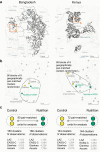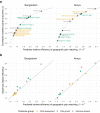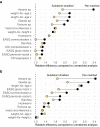Geographic pair matching in large-scale cluster randomized trials
- PMID: 38316755
- PMCID: PMC10844220
- DOI: 10.1038/s41467-024-45152-y
Geographic pair matching in large-scale cluster randomized trials
Abstract
Cluster randomized trials are often used to study large-scale public health interventions. In large trials, even small improvements in statistical efficiency can have profound impacts on the required sample size and cost. Location integrates many socio-demographic and environmental characteristics into a single, readily available feature. Here we show that pair matching by geographic location leads to substantial gains in statistical efficiency for 14 child health outcomes that span growth, development, and infectious disease through a re-analysis of two large-scale trials of nutritional and environmental interventions in Bangladesh and Kenya. Relative efficiencies from pair matching are ≥1.1 for all outcomes and regularly exceed 2.0, meaning an unmatched trial would need to enroll at least twice as many clusters to achieve the same level of precision as the geographically pair matched design. We also show that geographically pair matched designs enable estimation of fine-scale, spatially varying effect heterogeneity under minimal assumptions. Our results demonstrate broad, substantial benefits of geographic pair matching in large-scale, cluster randomized trials.
© 2024. The Author(s).
Conflict of interest statement
The authors declare no competing interests.
Figures






Update of
-
Geographic pair-matching in large-scale cluster randomized trials.medRxiv [Preprint]. 2023 May 23:2023.04.30.23289317. doi: 10.1101/2023.04.30.23289317. medRxiv. 2023. Update in: Nat Commun. 2024 Feb 5;15(1):1069. doi: 10.1038/s41467-024-45152-y. PMID: 37205361 Free PMC article. Updated. Preprint.
References
-
- Hayes, R. J. & Moulton, L. H. Cluster randomised trials. (Taylor & Francis Group, 2017).

